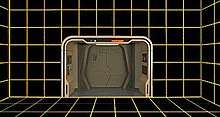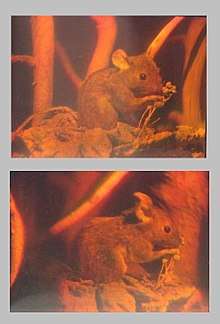Holodeck
The Holodeck is a fictional device from the television franchise Star Trek. It is a stage where participants may engage with different virtual reality environments. From a storytelling point of view, it permits the introduction of a wide variety of locations and characters, such as events and persons in the Earth's past and imaginary places or beings, that would otherwise require complicated set-ups such as time-travel or dream sequences. Writers often use it as a way to pose philosophical questions.
| Holodeck | |
|---|---|
 A vacant holodeck on the Enterprise-D; the arch and exit are prominent. |
In the series Star Trek: Deep Space Nine, the device is referred to as a holosuite. Quark maintains several of them in his bar aboard the titular station and rents them out to customers.
Although the Holodeck is supposed to be a safe alternative to reality, many Star Trek shows feature holodeck-gone-bad plots in which real-world dangers become part of what is supposed to be a controlled environment.[1]
Origins

The word holography comes from the Greek words ὅλος (holos; "whole") and γραφή (graphē; "writing" or "drawing"). Hungarian-British physicist Dennis Gabor received the Nobel Prize in Physics in 1971 "for his invention and development of the holographic method", work done in the late 1940s. The discovery was an unexpected result of research into improving electron microscopes; the original technique is still used and is known as electron holography. Optical holography was made possible the development of the laser in 1960. The first practical optical holograms recording 3D objects were made in 1962 by Yuri Denisyuk in the Soviet Union and by Emmett Leith and Juris Upatnieks at the University of Michigan, USA.
Science-fiction writer Ray Bradbury wrote about a technology-powered "nursery" in his 1950 story "The Veldt".
The Star Trek holodeck was inspired by inventor Gene Dolgoff, who owned a holography laboratory in New York City.[2] Star Trek creator Gene Roddenberry met Dolgoff in 1973.
The first appearance of a holodeck in Star Trek came in Star Trek: The Animated Series, in the episode "The Practical Joker", where it was called the recreation room. Dr. McCoy, Sulu and Uhura are trapped inside it by the ship's computer. Within the fictional timeline of the Star Trek universe, it was not until 1988 in the Star Trek: The Next Generation episode "The Big Goodbye" that the holodeck played a central part of the plot.[3]
Depiction
The holodeck is shown as a large room with black walls, floor and ceiling, gridded with widely spaced bright yellow lines. Within this space, objects and people are simulated by a combination of materialization (using the same technique as the food replicators), beams and fields onto which holographic images are projected. The program manipulates the simulated environment to keep people from running into the walls by accident. Unlike food and other assembled matter, the holomatter usually disintegrates when the virtual-reality program ends or when it is removed from the holodeck. However, some episodes do show holomatter persisting beyond the confines of the holodeck. In "Encounter at Farpoint", for example, Wesley Crusher falls into a holographic stream, and he is still wet after leaving the holodeck.[4]
A panel outside the entrance offers the user various settings to control the experience. Once inside, the holodeck is controlled by voice commands, The Star Trek: The Next Generation episode "Elementary, Dear Data" shows a physical computer terminal (the "Arch") which also provides access to the holodeck controls—but it must be summoned by voice command.
The same episode explores the metaphysical questions raised when a holodeck character becomes self-aware and considers his own identity and existence.[5] Unable to give him life outside the holodeck, Captain Picard saves Moriarty's program against the day when that will be possible. A major story arc of the series Star Trek:Voyager is the development of a holographic emergency medical program known as The Doctor into a sentient being. Originally restricted to sickbay, the character is given a device to wear that allows him to move freely about the ship and interact with others, starting him on his long journey.
Scenes set in the holodeck usually show a user or users interacting with the virtual-reality environment and its characters. Sometimes the user plays a passive role as an unseen observer of the simulated environment.
Star Trek characters use holodecks for work as well as recreation. Tasha Yar creates a martial arts sparring partner. Simulations re-create undertakings in science, logistics and law. Star Trek: The Next Generation made frequent use of Captain Jean-Luc Picard's fondness for playing the part of one of his boyhood heroes, fictional detective Dixon Hill. Holonovelists provide original scenarios and stories for use on the holodeck. Some users develop a pathological addiction to the holodeck, a condition known to the characters as holo-addiction. Star Trek: Voyager introduces alien beings known as photonic lifeforms who believe the holodeck program is real and interact with the ship's crew that way.
By 2399, when Star Trek: Picard begins, holomatrix guest rooms have become a familiar amenity. On board Rios' ship, La Sirena, the hospitality hologram (one of Rios' holographic doppelgängers) escorts Picard to a perfect re-creation of the study in his chateau in France. According to the hologram, who came with the ship's basic installation, Zhaban provided the holoscans, thinking Picard might feel more at home. The view outside the window is a projection—Picard says "Hold" to pause the display and the birdsong—but all the objects within have been materialized, including Dahj's necklace.
One of the opening scenes of the 1994 film Star Trek: Generations features a holodeck scene showing a vessel at sea.[6] In real life the ship Lady Washington was used to create the holodeck scenario.[7]
Reception
The Star Trek: The Next Generation episode "The Big Goodbye" (airdate January 11, 1988), featuring a story set in the holodeck, was honored with a Peabody Award in recognition of its "new standard of quality for first-run syndication". [8] "The Big Goodbye" was also nominated for two Emmy Awards in the categories of Outstanding Cinematography for a Series and Outstanding Costumes for a Series; costume designer William Ware Theiss won the award.[9][10] "The Big Goodbye" is the only Star Trek episode to win a Peabody Award.[11]
Similar technology in other works
- Author Alexander Moszkowski may have been the first person to envisage something resembling a 'holodeck' concept.
- The Nursery in "The Veldt" (1950) by Ray Bradbury
- In 1965, computer scientist Ivan Sutherland imagined an artificial environment in which mere 'displays' might attain to solid reality.[12]
- Russian science-fiction movie Moscow-Cassiopeia (1973) shows a "Surprise Room" which operates in a similar way to a holodeck.
- Japanese TV series Space Battleship Yamato (1974) features a "resort room" capable of creating simulated environments.
- The X-Men comic book series depicts a training room which was originally depicted as a mechanical affair, but later as using holograms and other sensory simulation.
- The HoloShed aboard the Nimbus in Futurama's fourth televised season resembles the holodeck in function and aesthetic, though the holograms have the ability to become real.
- Abed Nadir's "dreamatorium" from the third season of the U.S. television sitcom Community is inspired by the holodeck both in its function and in its aesthetic, though the simulations are a product of imagination rather than actual projections.
Notes
- Thomas Richards, The Meaning of Star Trek. New York: Doubleday (1997): 108–109. The Enterprise-D "has two mechanisms aboard that seem especially prone to failure ... the transporter and the holodeck."
- "Meet The Man Behind The Holodeck, Part 1". StarTrek.com. Retrieved 2016-01-11.
- Pendlebury, Ty. "Making the holodeck a virtual reality". CNET. Retrieved 2019-12-02.
- Phil Farrand. The Nitpicker's Guide for Next Generation Trekkers New York: Dell (1993)
- Richards (1997): 114
- "Star Trek: The Next Generation—The Big Good-Bye". Peabody Awards. Retrieved June 15, 2016.
- "Primetime Emmy Award Database". Emmys.com. Retrieved July 5, 2013.
- Turner, George (October 1988). "And the Winners are ..." American Cinematographer. 69 (10). (subscription required)
- Sutherland, I. (1965). The ultimate display. Proceedings of IFIP Congress 1965, 506–508.
References
- P. Farrand, Nitpicker's Guide for Deep space Nine Trekkers New York: Dell (1996): 44–47
- Lois H. Gresh & Robert Weinberg, Chapter 7, "The Holodeck" The Computers of Star Trek. New York: Basic Books (1999): 127–144
- R. Sternbach & M. Okuda, Star Trek: The Next Generation Technical Manual New York: Bantam Books (1991)
- Gene Dolgoff, "Reproduction of Transmitted, Pre-recorded, Holographic Television Signals in Color" New York: Institute of Electrical and Electronic Engineers (IEEE)(July, 1968)
- Stoppe, Sebastian (2016). "Getting Immersed in Star Trek, Storytelling Between "True" and "False" on the Holodeck" (PDF). SFRA Review (316): 4–15. Retrieved July 20, 2016.
